An Integrated Approach for Saturation Modeling Using Hydraulic Flow Units: Examples from the Upper Messinian Reservoir
Abstract
1. Introduction
2. Geological Setting
3. Materials and Methods
3.1. Reservoir Hydraulic Flow Units (HFUs)
- Øz = the normalized porosity in a fraction, and
- Φ = porosity in a fraction, K = permeability in milli Darcy (mD).
3.2. Well Log Analysis
3.3. Neural Log Analysis
3.4. Free Water Level (FWL) and Fluid Contacts
3.5. Mercury Injection Capillary Pressure (MICP)
- r = pore radius, σ = the interfacial tension, θ = contact angle,
- Pc = capillary pressure (absolute applied pressure).
- Pc = capillary pressure (absolute applied pressure), σ = the interfacial tension,
- ρ = the density of water and hydrocarbon (gas or oil), g = the gravitational acceleration,
- h = the height above FWL, = specific gravity of brine,
- = specific gravity of hydrocarbons, 0.434 psi/ft = gradient of water.
3.6. Reservoir Capillary Pressure and Saturation Height Function
3.7. Leverett J-Function
- J = Leverett J-function, Pc = capillary pressure, σ = the interfacial tension, θ = contact angle,
- Φ = porosity in a fraction, K = permeability in mile Darcie’s (mD).
4. Results
4.1. Facies Evaluation
4.1.1. Flood Plain Environment
4.1.2. Tidally Influenced Fluvial Channel Environment
4.1.3. Fluvial Channel Environment
4.1.4. Tidal Channel Environment
4.2. Hydraulic Flow Units (HFU)
4.3. Formation Evaluation
4.4. Neural Log FZI and Permeability Prediction
4.5. Saturation Height Model
- a = 1.4863, b = (−0.432) for HFU#1
- a = 1.3103, b = (−0.391) for HFU#2
- a = 1.2406, b = (−0.275) for HFU#3 and 4
- SW = water saturation (v/v); h = height above free water level (ft).
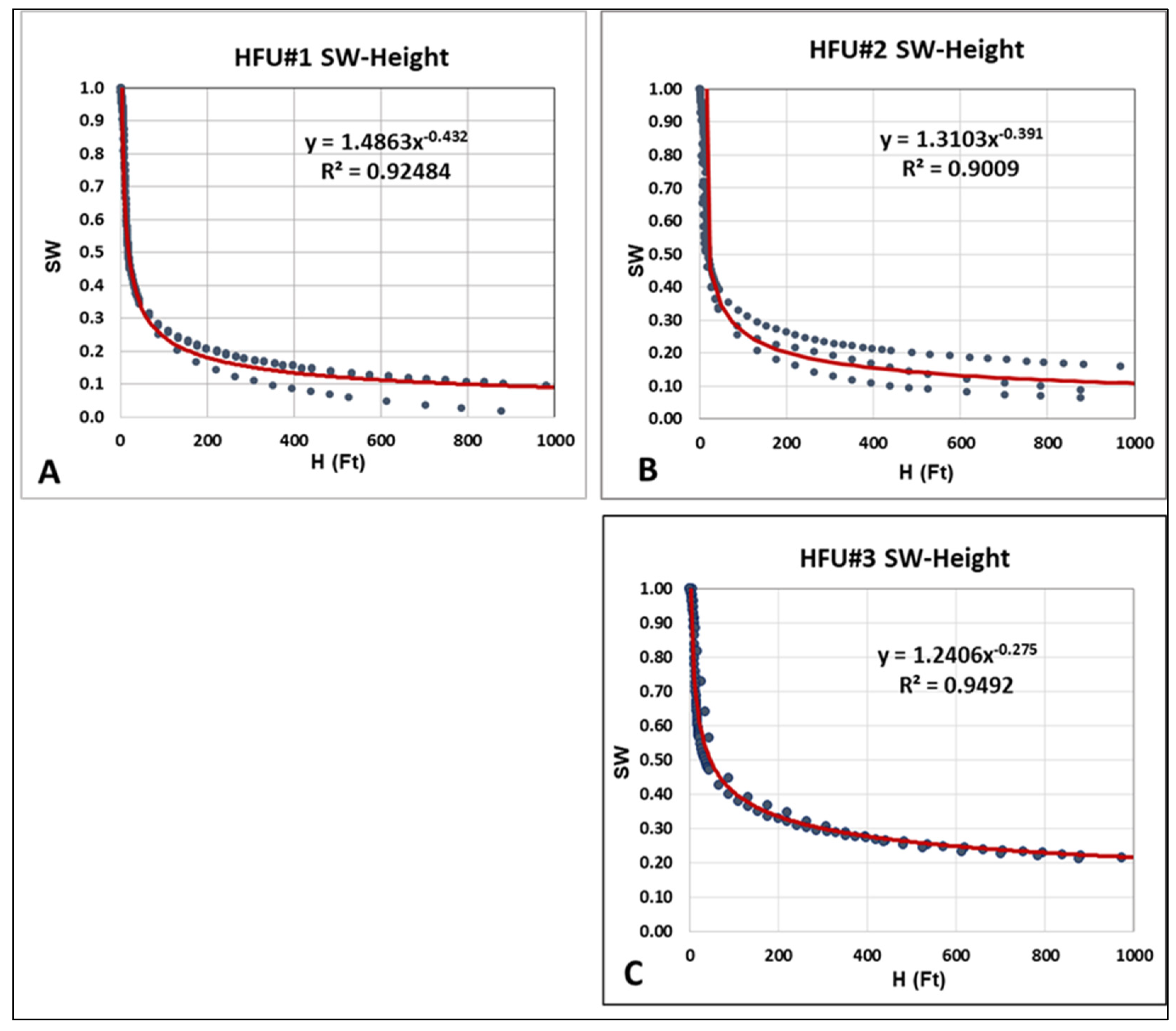
4.6. Water Saturation Using J-Function
- a = 0.4618, b = (−2.127) for HFU#1
- a = 0.1465, b = (−2.8) for HFU#2
- a = 0.100, b = (−3.12) for HFU#3 and 4
- where SW = water saturation (v/v); J = Leverett J-function.
5. Discussion
5.1. Depositional Environments, Flow Units, and Control upon Reservoir Quality
5.2. Flow Unit Identification and Validation of Irreducible Water Saturation and SW Estimation
6. Conclusions
Author Contributions
Funding
Data Availability Statement
Acknowledgments
Conflicts of Interest
References
- Leila, M.; Kora, M.A.; Ahmed, M.A.; Ghanem, A. Sedimentology and reservoir characterization of the upper Miocene Qawasim Formation, El-Tamad oil field onshore Nile Delta, Egypt. Arab. J. Geosci. 2016, 9, 17. [Google Scholar] [CrossRef]
- Novak, K.; Malvik, T.; Velic, J.; Simon, K. Increased hydrocarbon recovery and CO2 storage in Neogene sandstones, a Croatian example: Part II. Environ. Earth Sci. 2014, 71, 3641–3653. [Google Scholar] [CrossRef]
- Abdel Aal, A.; Price, R.; Vital, J.; Sharallow, J. Tectonic evolution of the Nile delta, its impact on sedimentation and hydrocarbon potential. In Proceedings of the 12th EGPC Exploration and Production Conference, Cairo, Egypt, 12–15 November 1994; pp. 19–34. [Google Scholar]
- Abdullah, E.; Al-Areeq, N.; Elmahdy, M.; Barakat, M.K. A new insight into the structural architecture of Sharyoof field, Say’un–Masilah basin, Yemen. Arab. J. Geosci. 2021, 14, 1977. [Google Scholar] [CrossRef]
- Ali, A.M.; Radwan, A.E.; Abd El-Gawad, E.A.; Abdel-Latief, A.A. 3D Integrated Structural, Facies and Petrophysical Static Modeling Approach for Complex Sandstone Reservoirs: A Case Study from the Coniacian–Santonian Matulla Formation, July Oilfield, Gulf of Suez, Egypt. Nat. Resour. Res. 2021, 31, 385–413. [Google Scholar] [CrossRef]
- Radwan, A.E. Modeling the Depositional Environment of the Sandstone Reservoir in the Middle Miocene Sidri Member, Badri Field, Gulf of Suez Basin, Egypt: Integration of Gamma-Ray Log Patterns and Petrographic Characteristics of Lithology. Nat. Resour. Res. 2021, 30, 431–449. [Google Scholar] [CrossRef]
- Beiranvand, B.; Kamali, M.R. Petrophysical evaluation and determination of rock types in a carbonate reservoir in SW Iran with interpretation of petrography and geophysical well logs. Iran. Int. J. Sci. 2004, 5, 203–221. [Google Scholar]
- Al-Ibadi, H.; Al-Jawad, S.N. Permeability Evaluation of Carbonate Reservoir Using Hydraulic Unit Analyse: Case Study from Middle East Region. In Proceedings of the 82nd EAGE Conference & Exhibition, Amsterdam, The Netherlands, 8–11 December 2020; pp. 1–5. [Google Scholar]
- Dolson, J.; Shann, M.; Matbouly, S.; Harwood, C.; Rashed, R.; Hammouda, H. The petroleum potential of Egypt. AAPG Mem. 2001, 74, 453–482. [Google Scholar]
- Amaefule, J.; Altunbay, M.; Tiab, D.; Kersey, D.; Keelan, D. Enhanced reservoir description, using core and log data to identify hydraulic (flow) units and predict permeability in uncored intervals/wells. In Proceedings of the SPE 26436, Annual Technical Conference and Exhibition, Houston, TX, USA, 3–6 October 1993; pp. 3–6. [Google Scholar]
- El-Sharawya, M.; Leila, M.; Bakr, A.; Kamela, A. Petrophysical evaluation of the Messinian Abu Madi Formation in Salma delta gas field, northeastern onshore Nile Delta, Egypt. J. Environ. Sci. 2020, 49, 46–53. [Google Scholar]
- El-Adl, H.; Leila, M.; Ahmed, A.; Anan, T.; El-Shahat, A. Integrated sedimentological and petrophysical rock-typing of the Messinian Abu Madi Formation in South Batra gas field, onshore Nile Delta, Egypt. Mar. Pet. Geol. 2021, 124, 104835. [Google Scholar] [CrossRef]
- Mirzaei-Paiaman, A.; Ostadhassan, M.; Rezaee, R.; Saboorian, H.; Chen, Z. A new approach in petrophysical rock typing. J. Pet. Sci. Eng. 2018, 166, 445–464. [Google Scholar] [CrossRef]
- Abdullah, E.; Al-Areeq, N.; Al-Masgari, A.; Barakat, M.K. Petrophysical evaluation of the Upper Qishn clastic reservoir in Sharyoof oil Field, Sayun-Masilah Basin, Yemen. ARPN J. Eng. Appl. Sci. 2021, 16, 2375–2394. [Google Scholar]
- EGPC (Egyptian General Petroleum Corporation). Nile Delta and North Sinai, Field Discoveries and Hydrocarbon Potentials (A Comprehensive Overview); EGPC: Cairo, Egypt, 1994; p. 387. [Google Scholar]
- Barakat, M.K. Modern Geophysical Techniques for Constructing a 3D Geological Model on the Nile Delta, Egypt. Ph.D. Dissertation, Technical University of Berlin, Berlin, Germany, 2010. [Google Scholar] [CrossRef]
- Hassan, S.; Darwish, M.; Tahoun, S.S.; Radwan, A.E. An integrated high-resolution image log, sequence stratigraphy and palynofacies analysis to reconstruct the Albian–Cenomanian basin depositional setting and cyclicity: Insights from the southern Tethys. Mar. Pet. Geol. 2022, 137, 105502. [Google Scholar] [CrossRef]
- El-Gendy, N.H.; El-Nikhely, A.H.; Zakaria, A.H.; Hellish, H.M.; Nabawy, B.S.; Barakat, M.K. Pre-Stack Imaging for the Messinian Sub Salt Sequences in the Levantine Basin of the East Mediterranean: A Case Study, Offshore Lebanon. Iraqi Geol. J. 2023, 56, 1–18. [Google Scholar] [CrossRef]
- Corbett, P. Petroleum Geoengineering: Integration of static and dynamic models. In Society of Exploration Geophysicists and European Association of Geoscientists and Engineers; European Association of Geoscientists & Engineers: Amsterdam, The Netherlands, 2009. [Google Scholar]
- Soleimani, M.; Shokri, B.J. 3D static reservoir modeling by geostatistical techniques used for reservoir characterization and data integration. Environ. Earth Sci. 2015, 74, 1403–1414. [Google Scholar] [CrossRef]
- Ghandra, V.; Barnett, A.; Corbett, P.; Geiger, S.; Wright, P.; Steele, R.; Milroy, P. Effective integration of reservoir rock-typing and simulation using near-wellbore upscaling. Mar. Pet. Geol. 2015, 67, 307–326. [Google Scholar] [CrossRef]
- Corbett, P.W.M.; Duarte, G.L.B. Understanding subsurface fluvial architecture from a combination of geological well test models and well test data. Geol. Soc. 2019, 488, 237–257. [Google Scholar] [CrossRef]
- Aadland, A.I.; Hassan, A.A. Hydrocarbon potential of the Abu El Gharadig basin in the Western Desert, Egypt. In Proceedings of the 8th Arab Petroleum Congress, Algiers, Algeria, 2 June 1972; p. 19. [Google Scholar]
- Leila, M.; Moscariello, A. Seismic stratigraphy and sedimentary facies analysis of the pre- and syn-Messinian salinity crisis sequences, onshore Nile Delta, Egypt. Implications for reservoir quality prediction. Mar. Petrol Geol. 2019, 101, 303–321. [Google Scholar] [CrossRef]
- Barakat, M.K.; Dominik, W. Seismic studies on the Messinian rocks in the onshore Nile Delta, Egypt. In Proceedings of the 72nd EAGE Conference, and Exhibition, Barcelona, Spain, 14–17 June 2010; pp. 5422–5426. [Google Scholar]
- Hamouda, A.Z.; El-Gendy, N.; El-Gharabawy, S.; Salah, M.; Barakat, M.K. Marine geophysical surveys and interpretations on the ancient Eunostos Harbor Area, Mediterranean Coast, Egypt. Egypt. J. Pet. 2023, 32, 47–55. [Google Scholar] [CrossRef]
- Leila, M.; El Sharawy, M.; Bakr, A.; Mohamed, A.K. Controls of facies distribution on reservoir quality in the Messinian incised-valley fill Abu Madi Formation in Salma delta gas field, northeastern onshore Nile Delta, Egypt. J. Nat. Gas Sci. Eng. 2022, 97, 104360. [Google Scholar] [CrossRef]
- El-Gendy, N.; Radwan, A.; Waziry, M.; Dodd, T.; Barakat, M.K. An integrated sedimentological, diagenesis, rock typing, image logs, artificial neural networks, and well logging analysis for reservoir quality assessment of the heterogeneous fluvial-deltaic Messinian Abu Madi reservoirs of the Salma Field, onshore East Nile Delta, Egypt. Mar. Pet. Geol. 2022, 145, 105910. [Google Scholar]
- Abu El-Ata, A.S.; El-Gendy, N.H.; El-Nikhely, A.H.; Raslan, S.; El-Oribi, M.; Barakat, M.K. Seismic characteristics and AVO response for non-uniform Miocene reservoirs in offshore eastern Mediterranean region, Egypt. Sci. Rep. 2023, 13, 8897. [Google Scholar] [CrossRef] [PubMed]
- Gunter, G.; Finneran, H.; Hartmann, D.; Miller, J. Early determination of reservoir flow units using an integrated petrophysical method. In Proceedings of the SPE Annual Technical Conference and Exhibition, San Antonio, TA, USA, 5–8 October 1997. [Google Scholar]
- Dubois, M.K.; Byrnes, A.P.; Bhattacharya, S.; Bohling, G.C.; Doveton, J.H.; Barba, R.E. Hugoton Asset Management Project (HAMP): Hugoton Geo Model Final Report; KGS Open File Report; 2006; Available online: https://www.kgs.ku.edu/PRS/publication/2007/OFR07_06/index.html (accessed on 28 November 2023).
- Jones, R.R.; McCaffrey, K.J.W.; Clegg, P.; Wilson, R.W.; Holliman, N.S.; Holdworth, R.E. Integration of regional to outcrop digital data: 3D visualization of multiscale geological models. Comput. Geosci. 2009, 35, 4–18. [Google Scholar] [CrossRef]
- El-Nikhely, A.; El-Gendy, N.H.; Bakr, A.M.; Zawra, M.S.; Ondrak, R.; Barakat, M.K. Decoding of seismic data for complex stratigraphic traps revealing by seismic attributes analogy in Yidma/Alamein concession area Western Desert, Egypt. J. Petrol Explo. Prod. Technol. 2022, 12, 3325–3338. [Google Scholar] [CrossRef]
- Radwan, A.E. Three-dimensional gas property geological modeling and simulation. In Sustainable Geoscience for Natural Gas Sub-Surface Systems; Wood, D.A., Cai, J., Eds.; Elsevier: Amsterdam, The Netherlands, 2022; pp. 29–45. [Google Scholar]
- Varavur, S.; Shebl, H.; Salman, S.M.; Shibasaki, T.; Dabbouk, C. Reservoir rock type definition in a giant cretaceous carbonate. In Proceedings of the SPE Middle East Oil and Gas Show and Conference, Manama, Bahrain, 12–15 March 2005. [Google Scholar]
- Leverett, M.C. Capillary behavior in porous solids. Trans. AIME 1941, 142, 159–172. [Google Scholar] [CrossRef]
- Barakat, M.K.; Nooh, A.Z. Reservoir quality using the routine core analysis data of Abu Roash “C” in Badr El Din-15 oil field, Abu Gharadig basin, North Western Desert, Egypt. J. Afr. Earth Sci. 2017, 129, 683–691. [Google Scholar] [CrossRef]
- Nabawy, B.S.; Shehata, A.M. Integrated petrophysical and geological characterization for the Sidi Salem-Wakar sandstones, off-shore Nile Delta, Egypt. J. Afr. Earth Sci. 2015, 110, 160–175. [Google Scholar] [CrossRef]
- Carman, P.C. Fluid flow through a granular bed. Trans. Inst. Chem. Eng. 1937, 15, 150–156. [Google Scholar] [CrossRef]
- Al-Ajmi, F.A.; Holditch, S.A. Permeability estimation using hydraulic flow units in a central Arabia reservoir. In Proceedings of the SPE Annual Technical Conference and Exhibition. SPE 63254, Dallas, TX, USA, 1–4 October 2000. [Google Scholar]
- Hamada, G.M.; AL-Awad, M.N.; Alsughayer, A. Variable Saturation Exponent Effect on the Determination of Hydrocarbon Saturation. In Proceedings of the SPE Asia Pacific Oil and Gas Conference and Exhibition, Melbourne, Australia, 8–10 October 2002. [Google Scholar] [CrossRef]
- Bateman, R.M. Openhole Log Analysis and Formation Evaluation; Schlumberger Education Services: Houston, TX, USA, 1985. [Google Scholar]
- Archie, G. The electric resistivity logs as an aid in determining some reservoir characteristics. Trans. Am. Int. Mech. Eng. 1942, 146, 54–62. [Google Scholar]
- Poupon, A.; Leveaux, J. Evaluation of Water Saturation in Shaly Formations. Log Anal. 1971, 12, SPWLA-1971-vXIIn4a1. [Google Scholar]
- Bhatt, A.; Helle, H.B.; Ursin, B. Application of committee machines in reservoir Characterization while drilling: A novel neural network approach in log analysis. In Proceedings of the 6th Nordic Symposium on Petrophysics, Trondheim, Norway, 15–16 May 2001. [Google Scholar]
- Tiab, D.; Donaldson, E.C. Petrophysics: Theory and Practice of Measuring Reservoir Rock and Fluid Transport Properties; Gulf Publishing: Houston, TX, USA, 1996; 926p. [Google Scholar]
- Gandhi, A.; Torres-Verdín, C.; Voss, B.; Gabulle, J.; Seminario, F. Construction of Reliable Static and Dynamic Multi-Layer Petrophysical Models in Camisea Gas Reservoirs, Peru. In Proceedings of the SPWLA 51st Annual Logging Symposium, Perth, Australia, 19–23 June 2010. [Google Scholar]
- Heidari, Z.; Torres-Verdín, C.; Mendoza, A.; Wang, G.L. Assessment of residual hydrocarbon saturation with the combined quantitative interpretation of resistivity and nuclear logs. Petrophysics 2011, 52, 217–237. [Google Scholar]
- Wardlaw, N.; Taylor, R. Mercury Capillary Pressure Curves and the Interpretation of Pore Structure and Capillary Behaviour in Reservoir Rocks. Bull. Can. Pet. Geol. 1976, 24, 225–262. [Google Scholar]
- Skelt, C.; Harrison, B. An Integrated Approach to Saturation Height Analysis. In Proceedings of the SPWLA 36th Annual Logging Symposium, Paris, France, 26–29 June 1995; pp. 1–6. [Google Scholar]
- Wiltgen, N.A.; Le Calvez, J.; Owen, K. Methods of Saturation Modeling Using Capillary Pressure Averaging and Pseudos. In Proceedings of the SPWLA 44th Annual Logging Symposium, Galveston, TX, USA, 22–25 June 2003; pp. 22–25. [Google Scholar]
- Jennings, R. Unsystematic security price movements, management earnings forecasts, and revisions in consensus analyst earnings forecasts. J. Account. Res. 1987, 25, 90–110. [Google Scholar] [CrossRef]
- Siddique, J.I.; Landis, F.A.; Mohyuddin, M.R. Dynamics of Drainage of Power-Law Liquid into a Deformable Porous Material. Open J. Fluid Dyn. 2014, 4, 403. [Google Scholar] [CrossRef][Green Version]
- Harrison, B.; Jing, X.D. Saturation height methods and their impact on volumetric hydrocarbon in place estimates. In Proceedings of the SPE Annual Technical Conference and Exhibition, New Orleans, LA, USA, 30 September–3 October 2001. [Google Scholar] [CrossRef]
- Lucia, F.J. Carbonate Reservoir Characterization; Springer: Berlin/Heidelberg, Germany, 1999. [Google Scholar]
- Miall, A. A review of the braided river depositional environment. Earth Sci. 1977, 13, 1–62. [Google Scholar] [CrossRef]
- Terwindt, J. Litho-facies of inshore estuarine and tidal-inlet deposits. Geol Mijnb. 1971, 50, 515–526. [Google Scholar]
- Van den Berg, J.; Boersma, J.; Van Gelder, A. Diagnostic sedimentary structures of the fluvial-tidal transition zone- evidence from deposits of the Rhine and Meuse. Neth. J. Geosci. 2007, 86, 306–387. [Google Scholar] [CrossRef]
- Tucker, M. Sedimentary Petrology; Blackwell Scientific: Oxford, UK, 2001; p. 272. [Google Scholar]
- Bridge, J. Fluvial facies models, recent Developments. Facies Model. Revisit. 2006, 84, 85–170. [Google Scholar] [CrossRef]
- Vandré, C.; Cramer, B.; Gerling, P.; Winsemann, J. Natural gas formation in the western Nile delta (Eastern Mediterranean): Thermogenic versus microbial. Org. Geochem. 2007, 38, 523–539. [Google Scholar] [CrossRef]
- Nabawy, B.S.; Lashin, A.; Barakat, M.K. Implementation of lithofacies and microfacies types on reservoir quality and heterogeneity of the Late Cretaceous Upper Bahariya Member in the Shurouk Field, Shoushan Basin, North-Western Desert, Egypt. J. Asian Earth Sci. 2022, 224, 105014. [Google Scholar] [CrossRef]
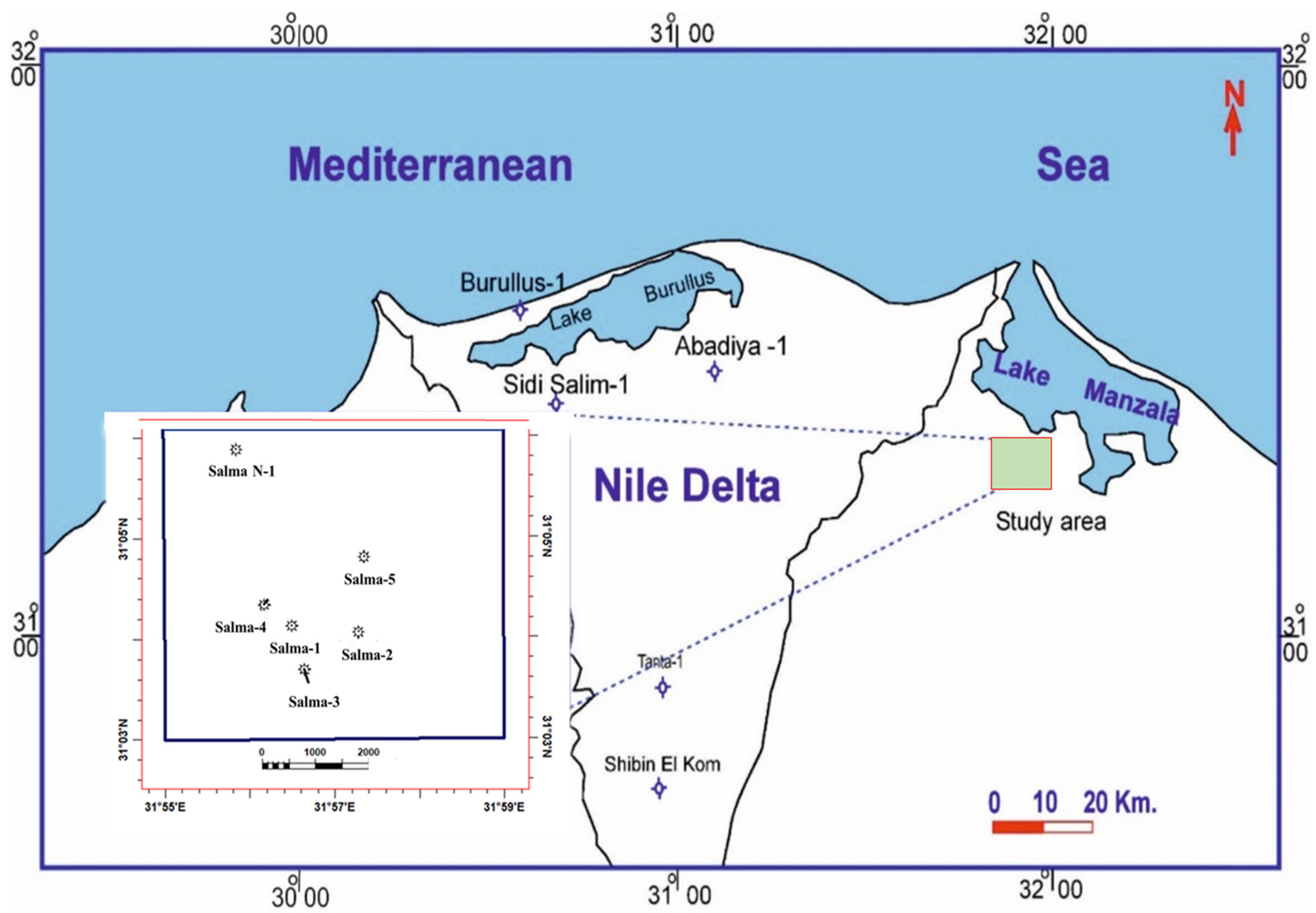

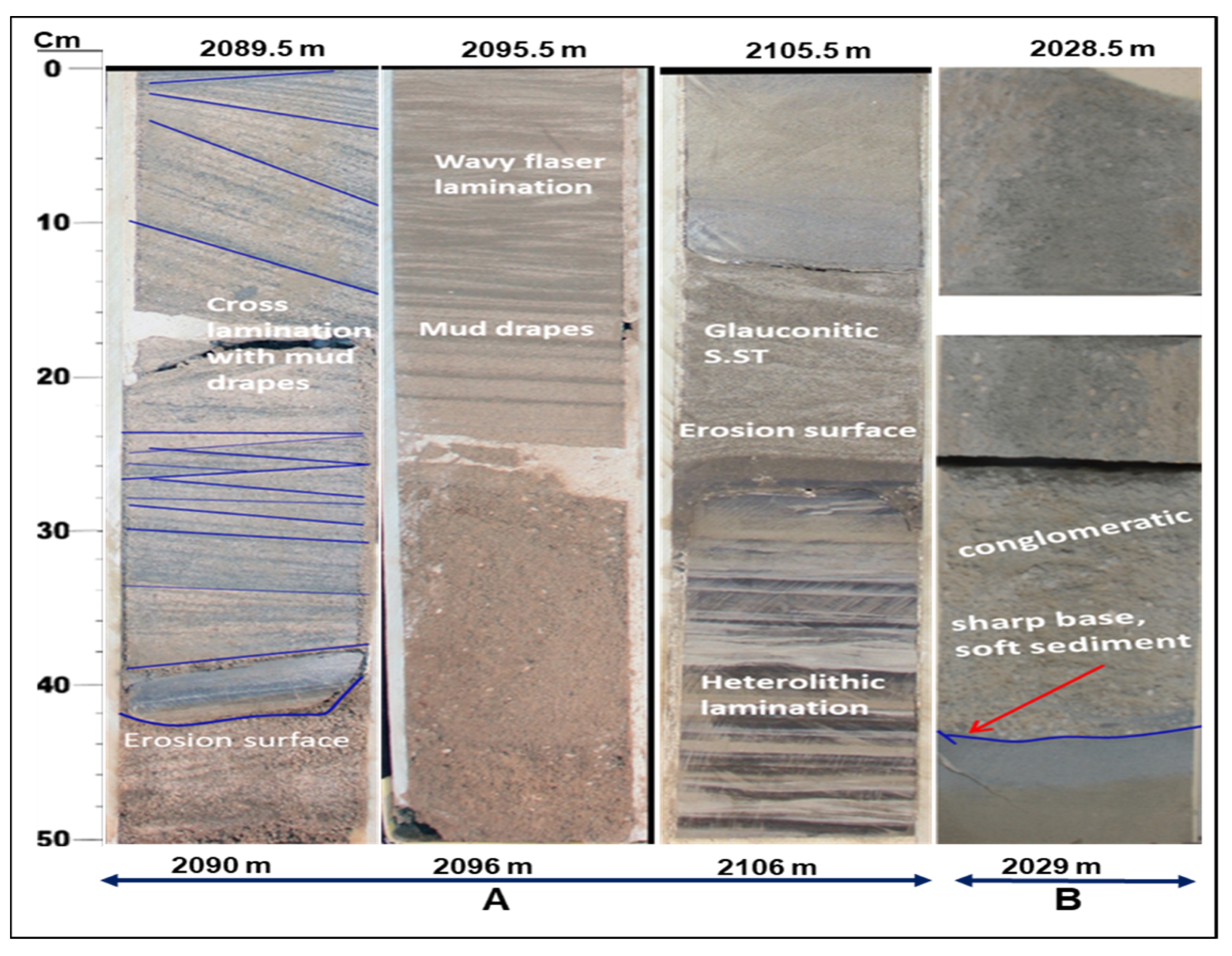
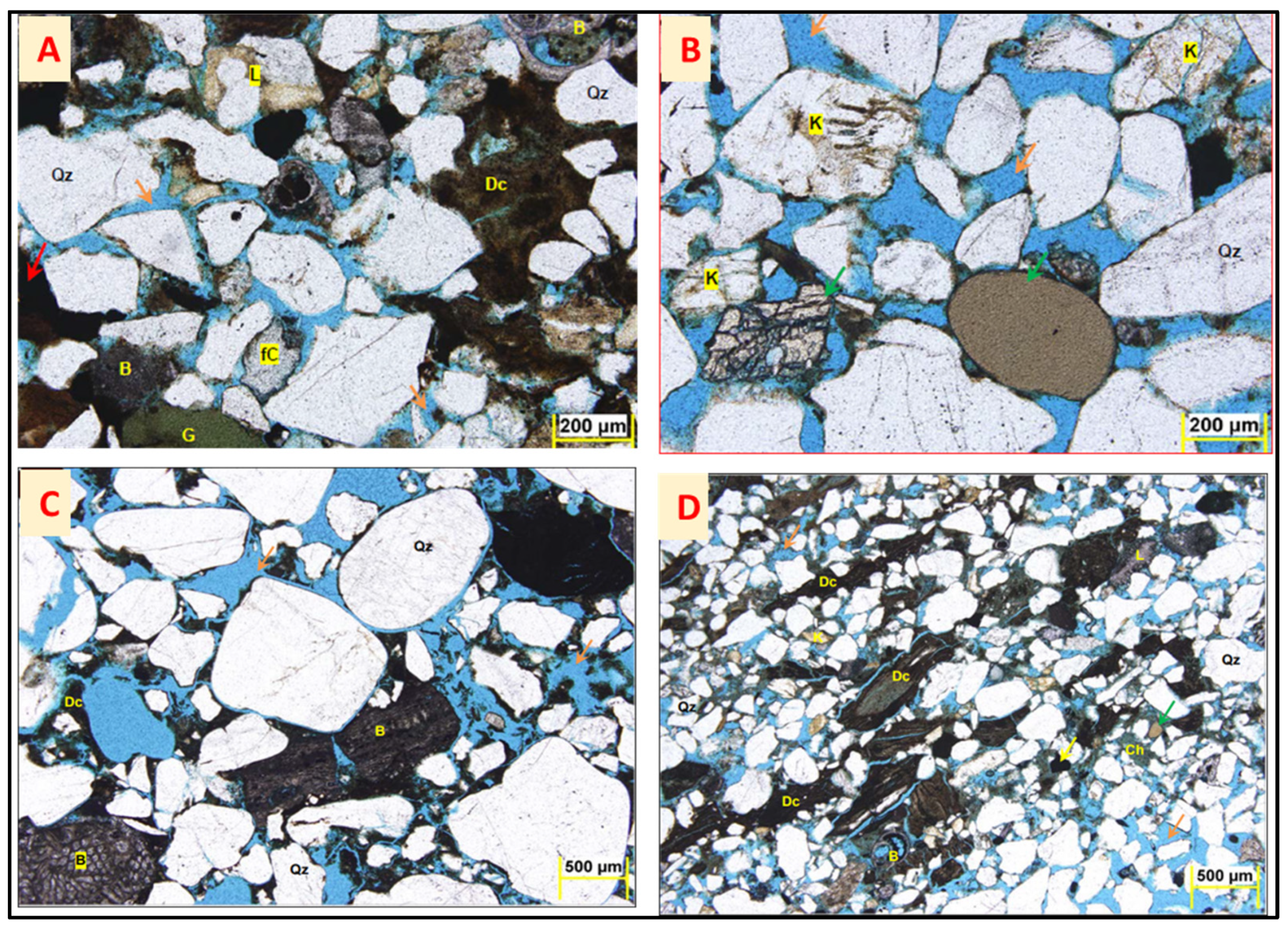
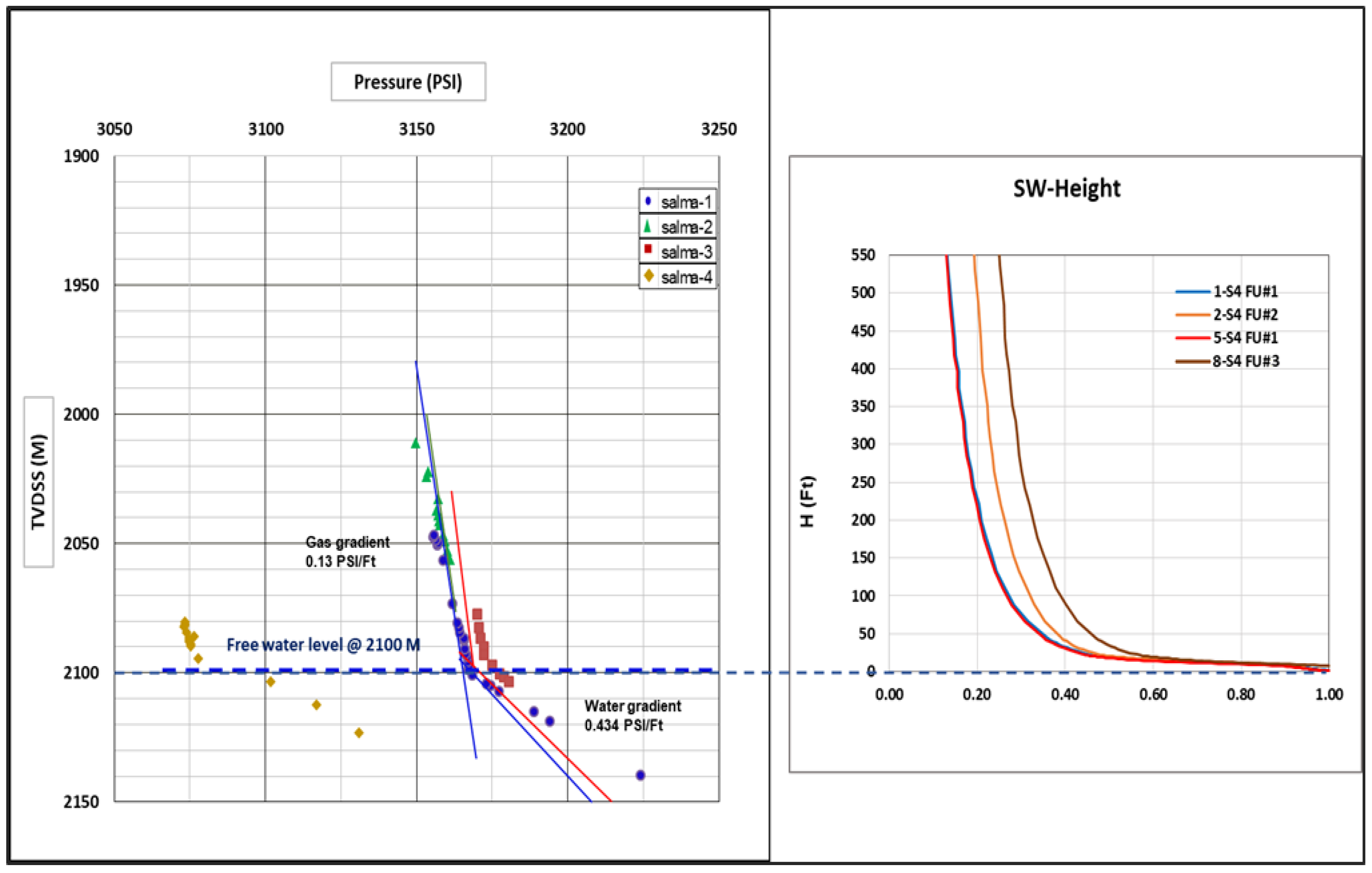

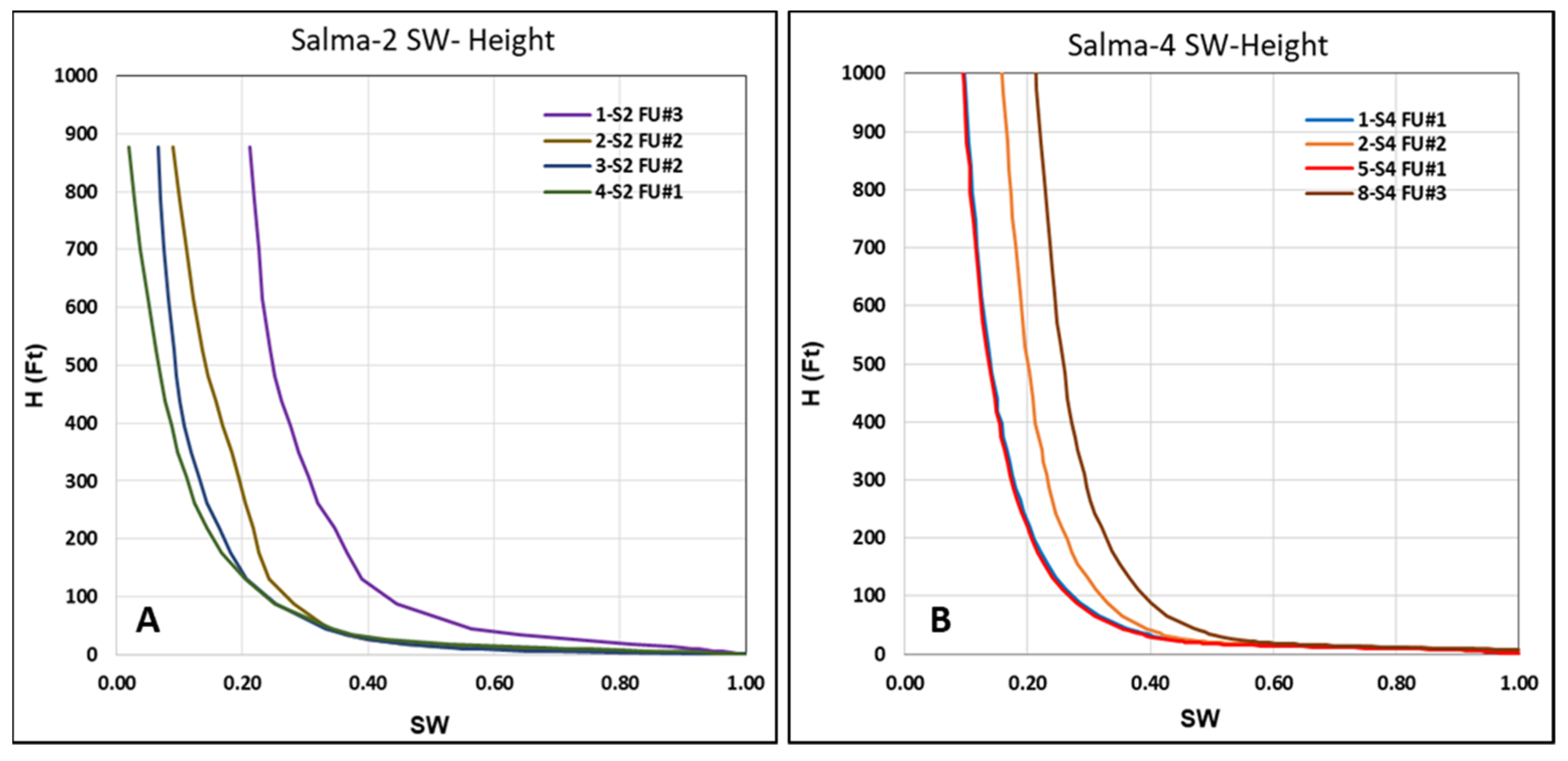
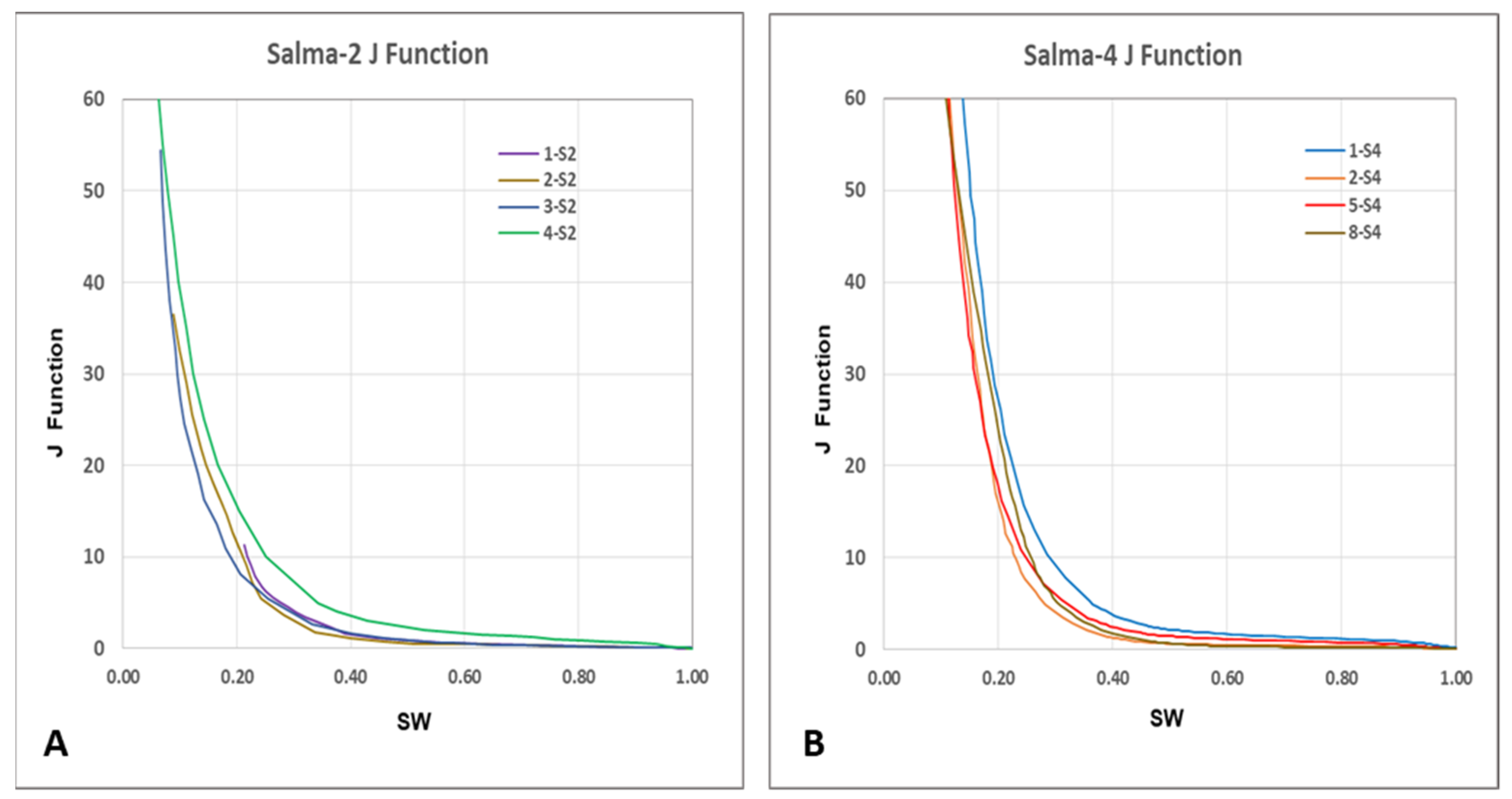
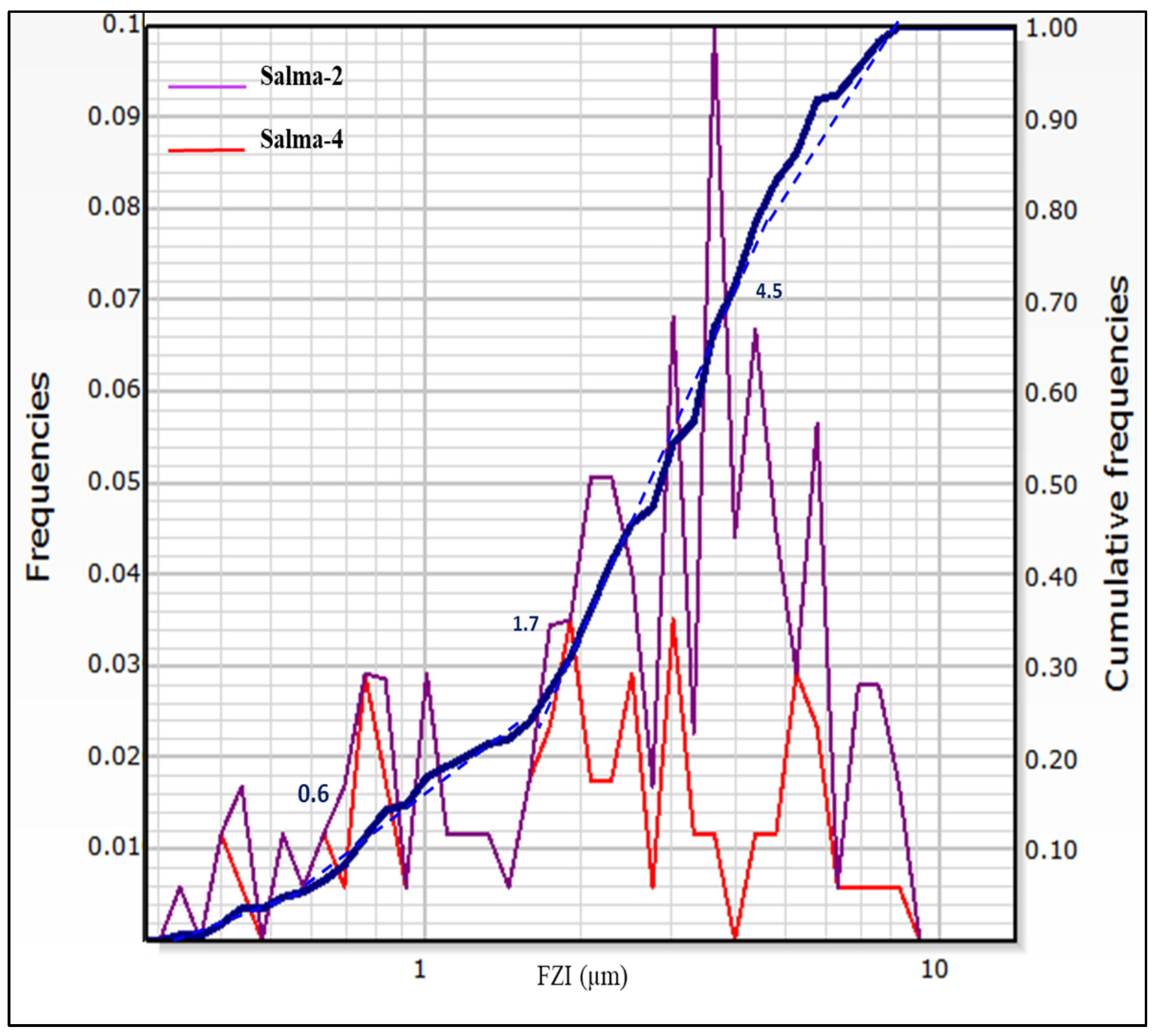
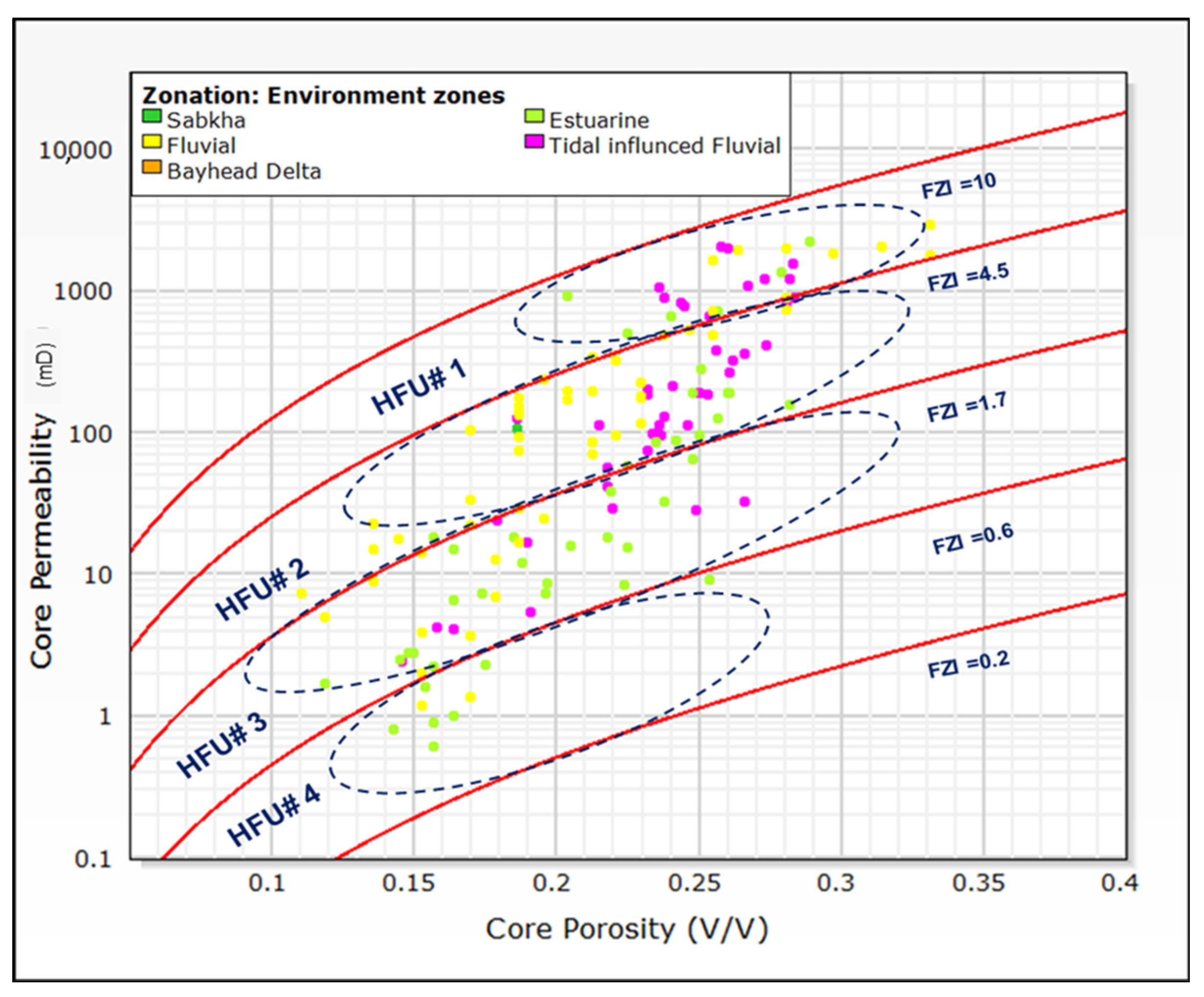
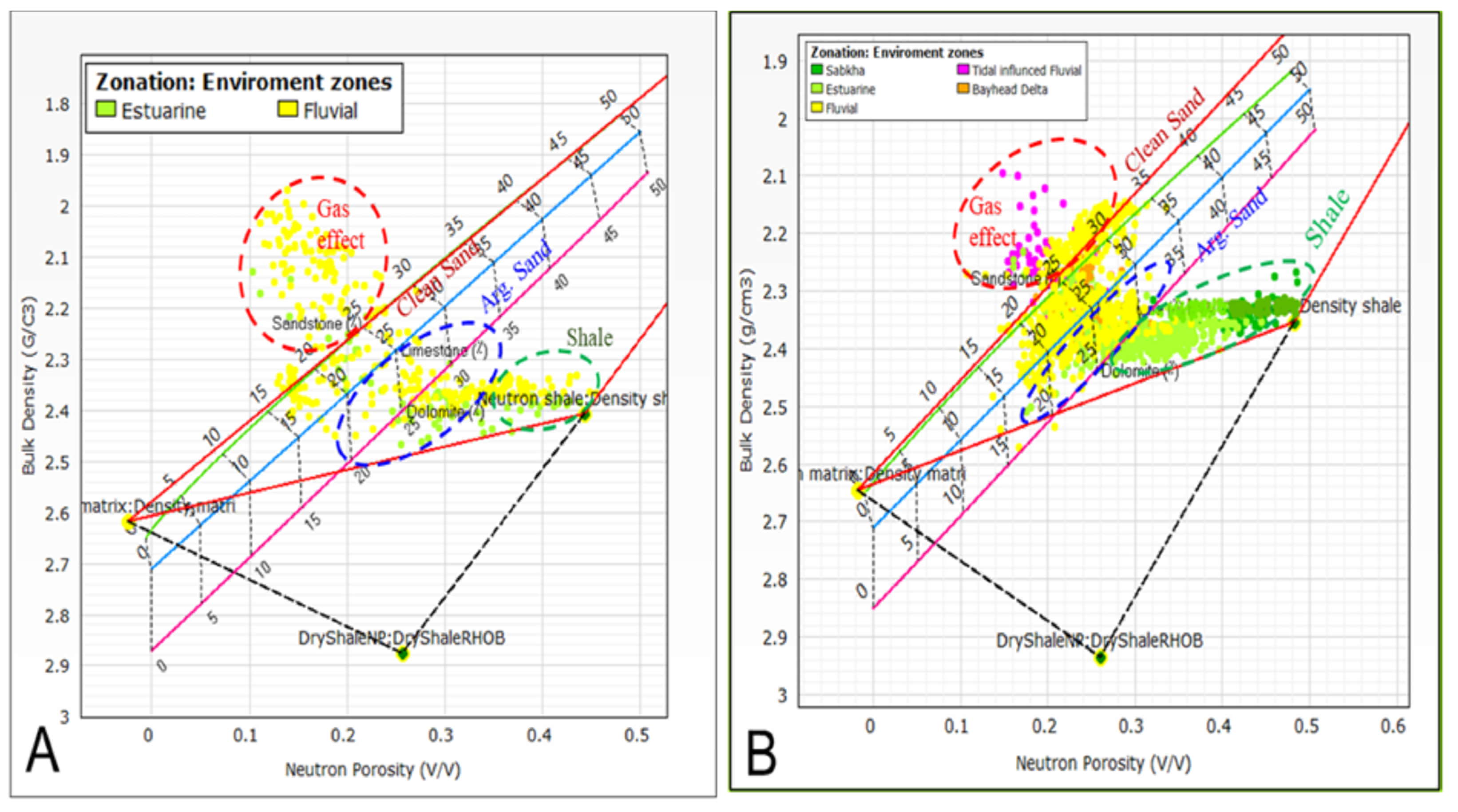
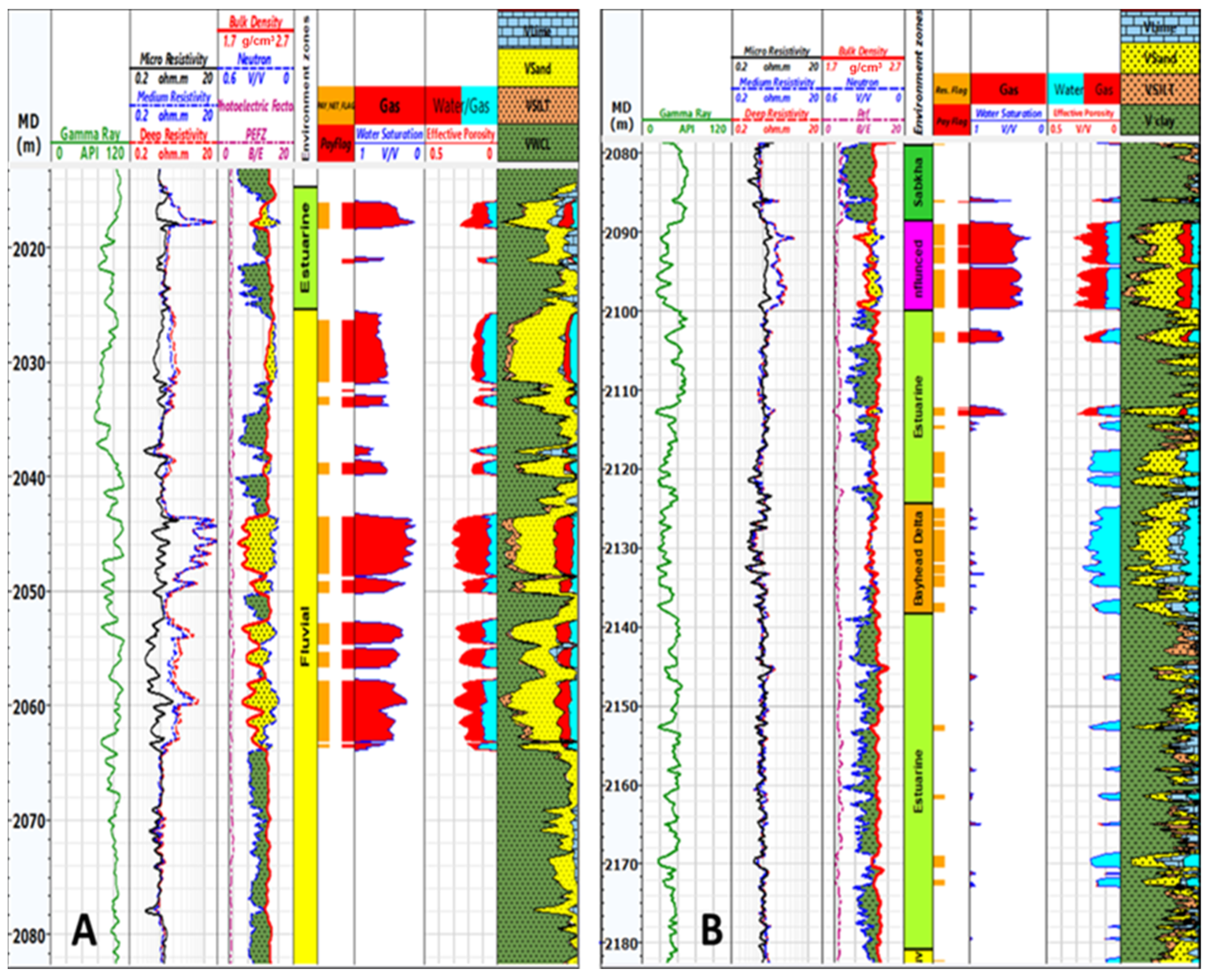
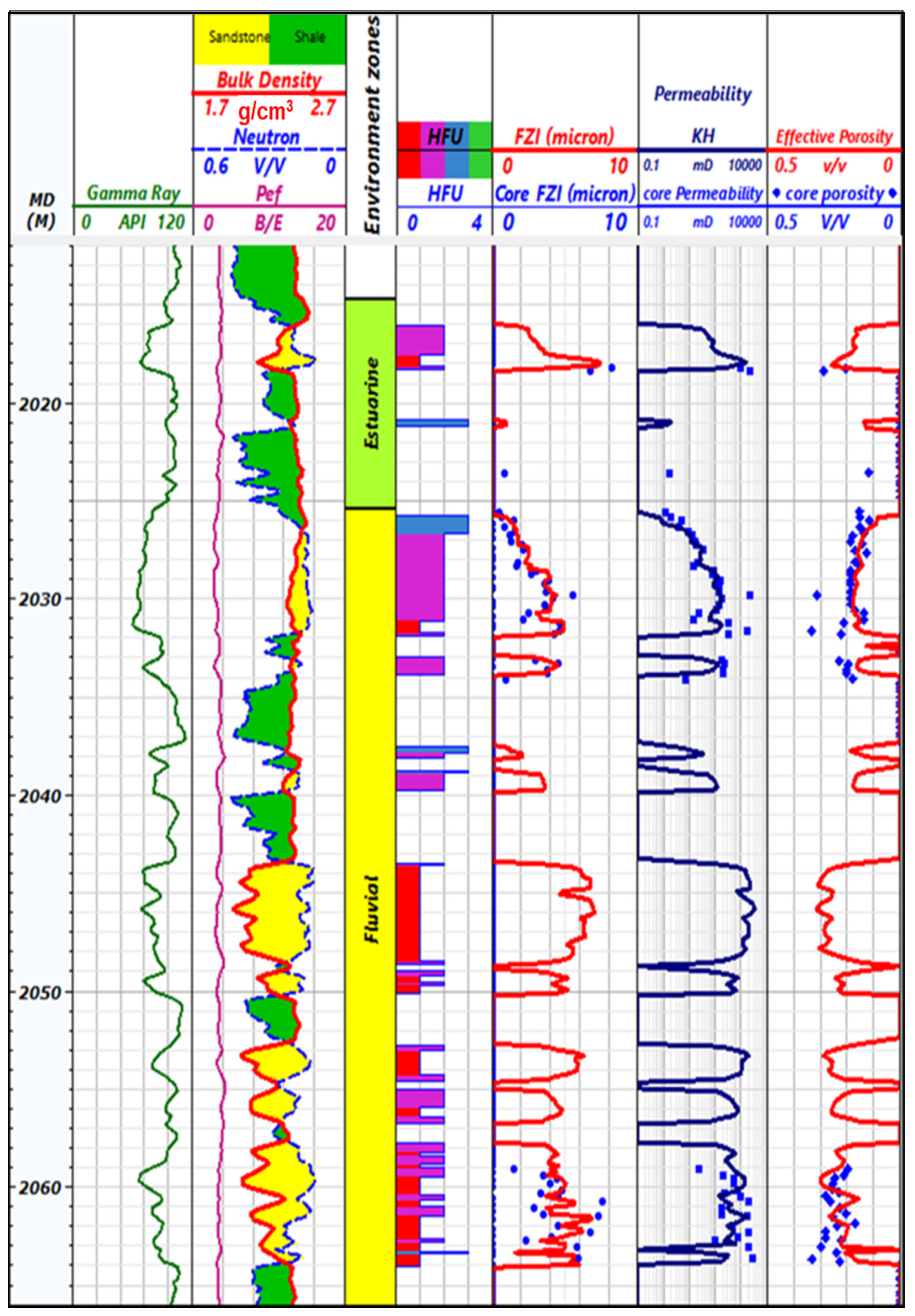


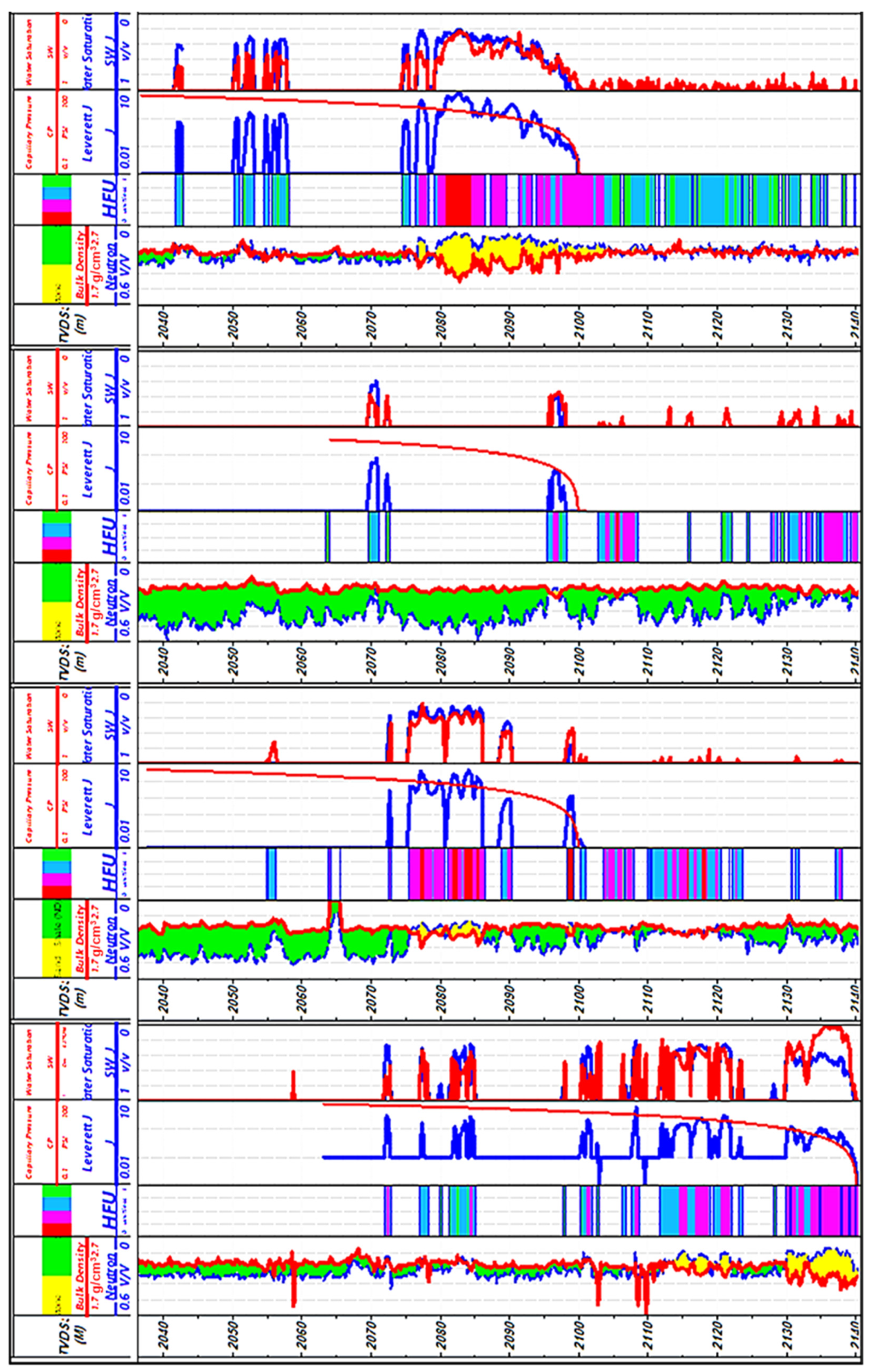
| Parameter | Contact Angles (°) | Parameter Description |
|---|---|---|
| σ Res | 50 | interfacial tension in the reservoir (gas–water) |
| θ Res | 0 | contact angle in the reservoir (gas–water) |
| σ Lab | 70 | interfacial tension in lab (air–water) |
| θ Lab | 0 | contact angle in lab (air–water) |
| σ Lab | 485 | interfacial tension in the lab (mercury–air) |
| θ Lab | 140 | contact angle in the lab (mercury–air) |
| Hydraulic Flow Unit | FZI (µm) | Porosity (%) | Permeability (mD) | Reservoir Quality |
|---|---|---|---|---|
| HFU# 1 | 4.5 to 10 | 25–33 | >900 | Excellent |
| HFU# 2 | 1.7 to 4.5 | 17–33 | 70–1000 | Good–Very Good |
| HFU# 3 | 0.6 to 1.7 | 12–33 | 4–100 | Moderate–Good |
| HFU# 4 | 0.2 to 0.6 | 15–30 | 0.6–8 | Low |
| Well | Zone | Top (m) | Bottom (m) | Gross (m) | Net (m) | Shale (%) | PHIE (%) | SW (%) | FZI (µm) | KH (mD) |
|---|---|---|---|---|---|---|---|---|---|---|
| Salma-2 | Estuarine | 2014 | 2025 | 11 | 2.3 | 24.5 | 18.9 | 35.9 | 3.9 | 357 |
| Fluvial | 2025 | 2088 | 63 | 23.3 | 18.9 | 21.5 | 43.0 | 4.5 | 636 | |
| Salma-4 | Tidally influenced Fluvial | 2088 | 2100 | 12 | 9.8 | 21.4 | 23.9 | 38.9 | 3.7 | 677 |
| Estuarine | 2100 | 2181 | 67 | 10.8 | 25.2 | 18.8 | 89.9 | 2.2 | 171 | |
| Bayhead Delta | 2124 | 2138 | 14 | 10.2 | 24.4 | 18.4 | 99.4 | 1.9 | 84 | |
| Fluvial | 2181 | 2291 | 110 | 64.9 | 21.0 | 19.7 | 99.8 | 3.5 | 684 |
Disclaimer/Publisher’s Note: The statements, opinions and data contained in all publications are solely those of the individual author(s) and contributor(s) and not of MDPI and/or the editor(s). MDPI and/or the editor(s) disclaim responsibility for any injury to people or property resulting from any ideas, methods, instructions or products referred to in the content. |
© 2023 by the authors. Licensee MDPI, Basel, Switzerland. This article is an open access article distributed under the terms and conditions of the Creative Commons Attribution (CC BY) license (https://creativecommons.org/licenses/by/4.0/).
Share and Cite
El-Gendy, N.H.; Mabrouk, W.M.; Waziry, M.A.; Dodd, T.J.; Abdalla, F.A.; Alexakis, D.E.; Barakat, M.K. An Integrated Approach for Saturation Modeling Using Hydraulic Flow Units: Examples from the Upper Messinian Reservoir. Water 2023, 15, 4204. https://doi.org/10.3390/w15244204
El-Gendy NH, Mabrouk WM, Waziry MA, Dodd TJ, Abdalla FA, Alexakis DE, Barakat MK. An Integrated Approach for Saturation Modeling Using Hydraulic Flow Units: Examples from the Upper Messinian Reservoir. Water. 2023; 15(24):4204. https://doi.org/10.3390/w15244204
Chicago/Turabian StyleEl-Gendy, Nader H., Walid M. Mabrouk, Mohamed A. Waziry, Thomas J. Dodd, Fathy A. Abdalla, Dimitrios E. Alexakis, and Moataz Khairy Barakat. 2023. "An Integrated Approach for Saturation Modeling Using Hydraulic Flow Units: Examples from the Upper Messinian Reservoir" Water 15, no. 24: 4204. https://doi.org/10.3390/w15244204
APA StyleEl-Gendy, N. H., Mabrouk, W. M., Waziry, M. A., Dodd, T. J., Abdalla, F. A., Alexakis, D. E., & Barakat, M. K. (2023). An Integrated Approach for Saturation Modeling Using Hydraulic Flow Units: Examples from the Upper Messinian Reservoir. Water, 15(24), 4204. https://doi.org/10.3390/w15244204










